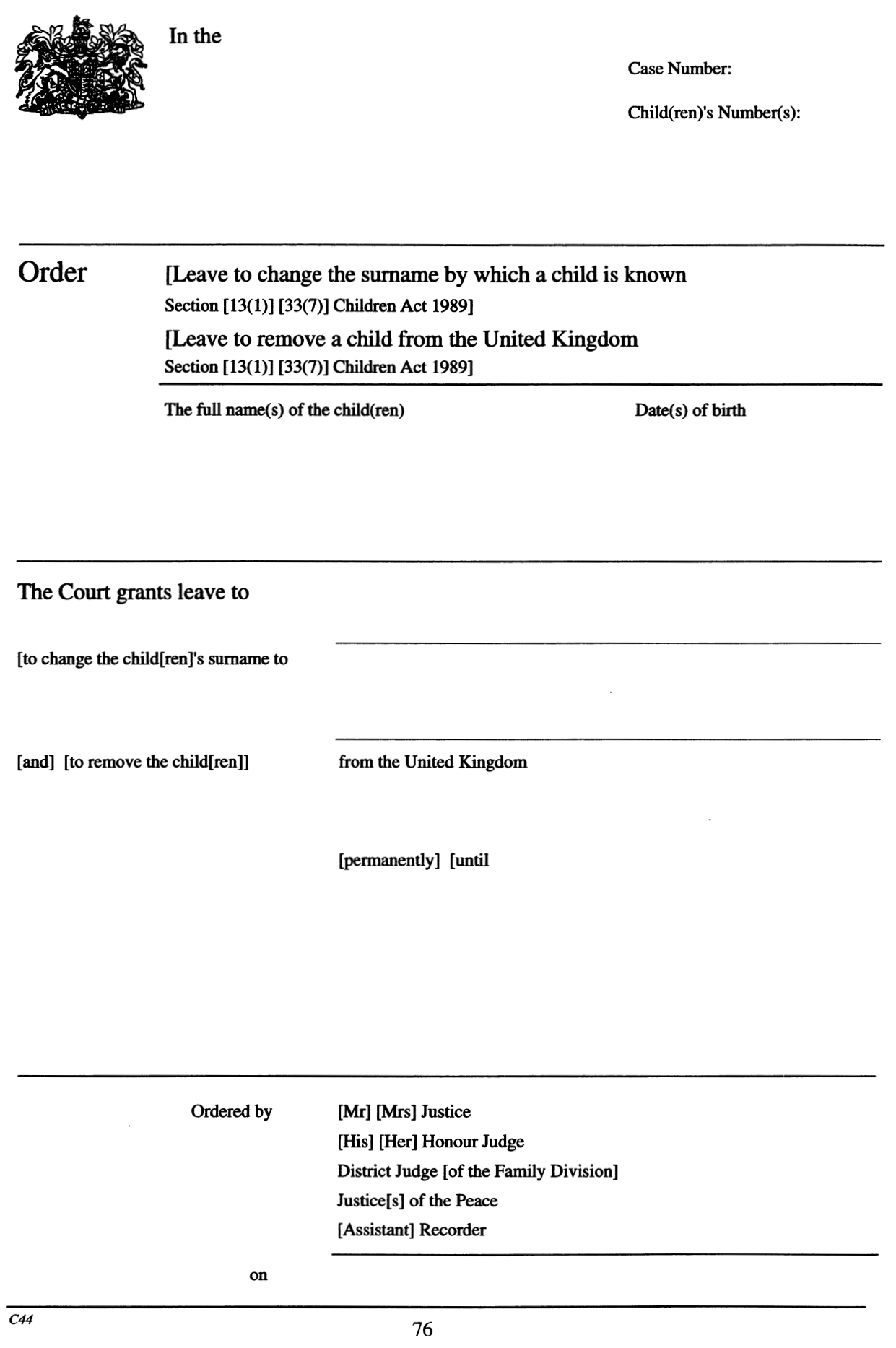Make a “free-standing” application to change a child’s surname (England & Wales)

If you want to change your child’s name, and you haven’t got consent from everyone with parental responsibility, you’ll need to have a court order allowing the child’s name to be changed.
When you need to apply for this kind of order
You’ll need to make a “free-standing” application for an order under section 13(1) or 14C(3) of the Children Act 1989 if —
- you want to change your child’s surname; and
your child is subject to —
You should make the “free-standing” application under —
- section 13(1) of the Act, when a Child Arrangements Order or Residence Order is in force
- section 14C(3) of the Act, when a Special Guardianship Order is in force
But you should make a different kind of application (see box below) if the child —
- has been placed for adoption (or an adoption agency has been authorised to place them), and an Adoption Order hasn’t been made yet
- is subject to any Care Order, interim Care Order, or Placement Order
If your application is successful the court will make an order conforming to Form C44 (pictured right).
(See Re B (Minors) (Change of Surname) [1996] 1 FLR 791 for a justification of why the application must be made under section 13(1) / section 14C(3). Note that Residence Orders have now been replaced by Child Arrangements Orders, and thus references to “Residence Orders” must be read as references to Child Arrangements Orders which include arrangements relating to who a child is to live with, or when a child is to live with any person.)
You’ll need to make a free-standing application under the Adoption and Children Act 2002 if the child has been placed for adoption (or an adoption agency has been authorised to place them), and an Adoption Order hasn’t been made yet.
You should make a free-standing application under section 33(7) of the Children Act 1989 if your child is subject to a Care Order (or interim Care Order).
You should apply for a Specific Issue Order (and not a free-standing application) when —
- you’re applying to change only your child’s first name (and not their surname); or
your child hasn’t been placed for adoption (and isn’t going to be), and they’re not subject to any —
— or all such orders have come to an end (meaning they’re no longer “in force”)
Changing only the first name when there’s a Special Guardianship Order
If your child is subject to a Special Guardianship Order, and you want to change only your child’s first name (and not their surname), then you don’t need a court order, so long as all the child’s special guardians agree to the change of name. They can exercise their parental responsibility to the exclusion of any other person with parental responsibility for the child (apart from another special guardian), under section 14C(1)(b) of the Children Act, subject to any other court order that’s in force.
However, you should still apply for a Specific Issue Order if your child has more than one special guardian and the special guardians don’t agree about the change of first name.
How to apply
Consider family mediation
Before you apply for any order under sections 13(1) or 14C(3), you’ll normally have to attend a Family Mediation Information and Assessment Meeting (MIAM), with a family mediator, to find out about family mediation and see if mediators can help resolve your dispute.
In some situations (e.g. if you’re applying for a “consent order”), you don’t have to attend an MIAM, and it’s possible to get an exemption.
If you don’t attend an MIAM, the court cannot process your court application, unless you can show evidence that you don’t need to attend one.
Forms you need to fill in
You need to fill in forms C1 and FM1 . You should return the completed forms to a court that deals with family matters. They’re very detailed forms and it’s important that every section is filled in correctly.
If you don’t want the other parent / guardians to know your address, phone number, or e-mail address, you can leave those sections blank. You’ll still need to give your contact details to the court by filling in form C8 , and including it with the other forms.
Leaflet CB1 — “Making an application: children and the family courts” contains detailed instructions about how to fill in the forms and make your application.
You’ll need to return your completed application form to the court nearest to where your child normally lives. Not all courts deal with family matters, so you should ask which is the right court (you can ask at your local county court).
![]() Find a court in England & Wales
Find a court in England & Wales
When there’s harm involved, or a risk of harm
You’ll also have to fill in form C1A if you believe your child has suffered (or is at risk of suffering) any kind of harm by any person who’s been involved in caring for your child, or who lives / has contact with them.
This includes any kind of harm from —
- any form of domestic abuse (whether psychological, physical, sexual, financial or emotional)
- violence within the household (including any threatening behaviour)
- seeing or hearing the ill treatment of another person
- child abduction
- drugs, alcohol or substance abuse
- other conduct or behaviour
There are guidance notes at the end of form C1A on how to fill in the form.
What it costs
You’ll have to pay a fee of £ 215 to apply for the court order. (See: Family court fees (EX50) )
You may be able to get a discount if you’re on specific benefits or have a low income.
![]() Find out if you have to pay court fees (and apply)
Find out if you have to pay court fees (and apply)

